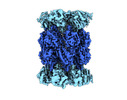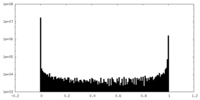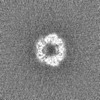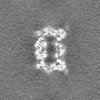+ Open data
Open data
- Basic information
Basic information
| Entry |  | ||||||||||||||||||
|---|---|---|---|---|---|---|---|---|---|---|---|---|---|---|---|---|---|---|---|
| Title | 20S proteasome from red blood cell lysate | ||||||||||||||||||
 Map data Map data | 20S proteasome from red blood cell lysate | ||||||||||||||||||
 Sample Sample |
| ||||||||||||||||||
| Biological species |  Homo sapiens (human) Homo sapiens (human) | ||||||||||||||||||
| Method | single particle reconstruction / cryo EM / Resolution: 3.4 Å | ||||||||||||||||||
 Authors Authors | Verbeke EJ / Taylor DW | ||||||||||||||||||
| Funding support |  United States, 5 items United States, 5 items
| ||||||||||||||||||
 Citation Citation |  Journal: Cell Rep / Year: 2022 Journal: Cell Rep / Year: 2022Title: The protein organization of a red blood cell. Authors: Wisath Sae-Lee / Caitlyn L McCafferty / Eric J Verbeke / Pierre C Havugimana / Ophelia Papoulas / Claire D McWhite / John R Houser / Kim Vanuytsel / George J Murphy / Kevin Drew / Andrew ...Authors: Wisath Sae-Lee / Caitlyn L McCafferty / Eric J Verbeke / Pierre C Havugimana / Ophelia Papoulas / Claire D McWhite / John R Houser / Kim Vanuytsel / George J Murphy / Kevin Drew / Andrew Emili / David W Taylor / Edward M Marcotte /  Abstract: Red blood cells (RBCs) (erythrocytes) are the simplest primary human cells, lacking nuclei and major organelles and instead employing about a thousand proteins to dynamically control cellular ...Red blood cells (RBCs) (erythrocytes) are the simplest primary human cells, lacking nuclei and major organelles and instead employing about a thousand proteins to dynamically control cellular function and morphology in response to physiological cues. In this study, we define a canonical RBC proteome and interactome using quantitative mass spectrometry and machine learning. Our data reveal an RBC interactome dominated by protein homeostasis, redox biology, cytoskeletal dynamics, and carbon metabolism. We validate protein complexes through electron microscopy and chemical crosslinking and, with these data, build 3D structural models of the ankyrin/Band 3/Band 4.2 complex that bridges the spectrin cytoskeleton to the RBC membrane. The model suggests spring-like compression of ankyrin may contribute to the characteristic RBC cell shape and flexibility. Taken together, our study provides an in-depth view of the global protein organization of human RBCs and serves as a comprehensive resource for future research. | ||||||||||||||||||
| History |
|
- Structure visualization
Structure visualization
| Supplemental images |
|---|
- Downloads & links
Downloads & links
-EMDB archive
| Map data |  emd_24822.map.gz emd_24822.map.gz | 168.1 MB |  EMDB map data format EMDB map data format | |
|---|---|---|---|---|
| Header (meta data) |  emd-24822-v30.xml emd-24822-v30.xml emd-24822.xml emd-24822.xml | 14.8 KB 14.8 KB | Display Display |  EMDB header EMDB header |
| Images |  emd_24822.png emd_24822.png | 89.9 KB | ||
| Masks |  emd_24822_msk_1.map emd_24822_msk_1.map | 178 MB |  Mask map Mask map | |
| Others |  emd_24822_half_map_1.map.gz emd_24822_half_map_1.map.gz emd_24822_half_map_2.map.gz emd_24822_half_map_2.map.gz | 165.4 MB 165.4 MB | ||
| Archive directory |  http://ftp.pdbj.org/pub/emdb/structures/EMD-24822 http://ftp.pdbj.org/pub/emdb/structures/EMD-24822 ftp://ftp.pdbj.org/pub/emdb/structures/EMD-24822 ftp://ftp.pdbj.org/pub/emdb/structures/EMD-24822 | HTTPS FTP |
-Validation report
| Summary document |  emd_24822_validation.pdf.gz emd_24822_validation.pdf.gz | 899.8 KB | Display |  EMDB validaton report EMDB validaton report |
|---|---|---|---|---|
| Full document |  emd_24822_full_validation.pdf.gz emd_24822_full_validation.pdf.gz | 899.4 KB | Display | |
| Data in XML |  emd_24822_validation.xml.gz emd_24822_validation.xml.gz | 15.1 KB | Display | |
| Data in CIF |  emd_24822_validation.cif.gz emd_24822_validation.cif.gz | 17.9 KB | Display | |
| Arichive directory |  https://ftp.pdbj.org/pub/emdb/validation_reports/EMD-24822 https://ftp.pdbj.org/pub/emdb/validation_reports/EMD-24822 ftp://ftp.pdbj.org/pub/emdb/validation_reports/EMD-24822 ftp://ftp.pdbj.org/pub/emdb/validation_reports/EMD-24822 | HTTPS FTP |
-Related structure data
| EM raw data |  EMPIAR-10848 (Title: single particle cryo-EM of red blood cell lysate (hemolysate, hemoglobin reduced, filtered by SEC) EMPIAR-10848 (Title: single particle cryo-EM of red blood cell lysate (hemolysate, hemoglobin reduced, filtered by SEC)Data size: 1.0 TB Data #1: Unaligned multiframe micrographs of size filtered red blood cell lysate [micrographs - multiframe]) |
|---|
- Links
Links
| EMDB pages |  EMDB (EBI/PDBe) / EMDB (EBI/PDBe) /  EMDataResource EMDataResource |
|---|
- Map
Map
| File |  Download / File: emd_24822.map.gz / Format: CCP4 / Size: 178 MB / Type: IMAGE STORED AS FLOATING POINT NUMBER (4 BYTES) Download / File: emd_24822.map.gz / Format: CCP4 / Size: 178 MB / Type: IMAGE STORED AS FLOATING POINT NUMBER (4 BYTES) | ||||||||||||||||||||||||||||||||||||
|---|---|---|---|---|---|---|---|---|---|---|---|---|---|---|---|---|---|---|---|---|---|---|---|---|---|---|---|---|---|---|---|---|---|---|---|---|---|
| Annotation | 20S proteasome from red blood cell lysate | ||||||||||||||||||||||||||||||||||||
| Projections & slices | Image control
Images are generated by Spider. | ||||||||||||||||||||||||||||||||||||
| Voxel size | X=Y=Z: 1.045 Å | ||||||||||||||||||||||||||||||||||||
| Density |
| ||||||||||||||||||||||||||||||||||||
| Symmetry | Space group: 1 | ||||||||||||||||||||||||||||||||||||
| Details | EMDB XML:
|
-Supplemental data
-Mask #1
| File |  emd_24822_msk_1.map emd_24822_msk_1.map | ||||||||||||
|---|---|---|---|---|---|---|---|---|---|---|---|---|---|
| Projections & Slices |
| ||||||||||||
| Density Histograms |
-Half map: half map B
| File | emd_24822_half_map_1.map | ||||||||||||
|---|---|---|---|---|---|---|---|---|---|---|---|---|---|
| Annotation | half map B | ||||||||||||
| Projections & Slices |
| ||||||||||||
| Density Histograms |
-Half map: half map A
| File | emd_24822_half_map_2.map | ||||||||||||
|---|---|---|---|---|---|---|---|---|---|---|---|---|---|
| Annotation | half map A | ||||||||||||
| Projections & Slices |
| ||||||||||||
| Density Histograms |
- Sample components
Sample components
-Entire : 20S proteasome
| Entire | Name: 20S proteasome |
|---|---|
| Components |
|
-Supramolecule #1: 20S proteasome
| Supramolecule | Name: 20S proteasome / type: complex / Chimera: Yes / ID: 1 / Parent: 0 / Details: 20S proteasome from red blood cell lysate |
|---|---|
| Source (natural) | Organism:  Homo sapiens (human) Homo sapiens (human) |
-Experimental details
-Structure determination
| Method | cryo EM |
|---|---|
 Processing Processing | single particle reconstruction |
| Aggregation state | particle |
- Sample preparation
Sample preparation
| Buffer | pH: 7.4 |
|---|---|
| Grid | Model: C-flat-1.2/1.3 / Support film - Material: CARBON / Support film - topology: HOLEY / Pretreatment - Type: GLOW DISCHARGE |
| Vitrification | Cryogen name: ETHANE / Chamber humidity: 100 % / Chamber temperature: 277.15 K / Instrument: FEI VITROBOT MARK IV |
- Electron microscopy
Electron microscopy
| Microscope | FEI TITAN KRIOS |
|---|---|
| Image recording | Film or detector model: GATAN K3 (6k x 4k) / Average electron dose: 42.58 e/Å2 |
| Electron beam | Acceleration voltage: 300 kV / Electron source:  FIELD EMISSION GUN FIELD EMISSION GUN |
| Electron optics | Illumination mode: FLOOD BEAM / Imaging mode: BRIGHT FIELD / Nominal defocus max: 2.5 µm / Nominal defocus min: 1.09 µm / Nominal magnification: 22500 |
| Experimental equipment |  Model: Titan Krios / Image courtesy: FEI Company |
+ Image processing
Image processing
-Atomic model buiding 1
| Refinement | Protocol: AB INITIO MODEL |
|---|
 Movie
Movie Controller
Controller




 Z (Sec.)
Z (Sec.) Y (Row.)
Y (Row.) X (Col.)
X (Col.)












































